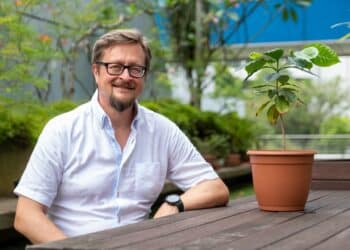Since the first Cup of Excellence auction was held, individual country auctions have seen producers and farms reach record prices well above US$180 per pound, and tiny producing regions gain overnight world-wide fame. GCR celebrates the competition that’s turned coffee producers into heroes.
When the Cup of Excellence (COE) held its first internet coffee auction 25 years ago in the world’s largest growing country Brazil, producers from across the world were watching with a healthy dose of scepticism. After all, in 1999 the internet was still in its infancy of presenting itself as a new form of business. It was still over 10 years before Google would be launched and become a mainstream tool of communications. Add to this that, despite its dominant spot in the world of coffee, Brazil was known for quantity over quality and the very idea that Brazilian beans could be sold at prices perhaps higher than seen in traditional markets was a source of curiosity few believed could or would materialise.
“We always knew Brazil had quality coffee and the specialty movement had already started to make progress and was getting into the gourmet market in Europe, but it was very difficult to make the transition to also become known for quality and not only quantity,” Marcelo Vieira, then Head of the Brazil Specialty Coffee Association, tells Global Coffee Report. “The Cup of Excellence really confirmed to the market that Brazilian producers could grow quality coffee, which was worth a premium.”
Vieira is a fourth-generation farmer in Brazil’s top producing region of Southern Minas. He is a board member and Head of the Coffee Committee at the prestigious Brazilian Rural Society, and continues to be as passionate about coffee and the COE as he was even before the first auction.
The idea for and concept behind the COE emerged from the Gourmet Coffee Project (GCP), launched by the London-based International Coffee Organization. The 1997 to 2000 project focused on what efforts lesser-known origins or producing countries could take to improve their quality in order to get access to the specialty market. The project was carried out in Brazil, Burundi, Ethiopia, Papua New Guinea, and Uganda.
“The model of an internet auction started with the Gourmet Coffee Project (GCP), using technology developed by SCAA (today, the Specialty Coffee Association). It would not be viable to organise the auction as an in-person event because it would be too expensive for most roasters and traders to come to a coffee growing country to participate, so the number of possible buyers would be restricted,” says Vieira. “These yearly meetings with the best experts in coffee quality and the best traders in the world market was always very exciting.”
The GCP was a success. Organisers say the term ‘Gourmet Robusta’ was invented as a result of Uganda producing such high-quality Robusta beans, and Brazil was recognised as having quality as well as quantity.
“It was amazing,” says long-term coffee connoisseur George Howell.
“When we were told the Gourmet Project was coming to an end, I hated the idea it would end as another report gathering dust in a library somewhere. This wasn’t about writing some great report but rather about getting things done. Brazil is the single most organised coffee country in the world, so I proposed to [Vieira] that we do a competition,” says Howell. At the time, Howell had already won international recognition for taking the skills of cupping to new heights, which in turn generated higher premiums for growers.
The first COE auction generated an average US$2.60 per pound for the top-scoring lot of 50 bags from winning farm Alterosa. The coffee world was in shock. Brazilian coffees had, up until this point, generally sold at a heavy discount, especially since the pulped natural processing method producer Claudio Carvalho Ottoni used for his winning lot was regarded as vastly inferior to the top-premium mild washed Arabica beans sold across Central America and Colombia.
The shock was near unbelievable when over the next few years Brazil’s COE winners would achieve US$49.75 per pound. This was more than 100 times the price generated in the global coffee market, which between 2001 and 2003, went through the Coffee Crisis when Arabica prices hit historic lows of 43 cents per pound, and hundreds of thousands of farmers went bankrupt as social disaster struck from Africa to Asia, and across Latin America and the Caribbean.
The fact roasters were willing to pay such steep premiums across the market for top-quality beans quickly won over the sceptics. Since that first auction, a total 15 countries from Burundi to Bolivia have signed up to join the world of possibilities that internet auctions present, and new record COE prices continue to defy expectations.
“The results were exceptional and quite literally caused a revolution, both as far as quality was concerned across the word of coffee but also because of the way the coffee growers were presented,” says Silvio Leite, Chief Judge at the COE competitions.
As he speaks to GCR on the sidelines of the COE finals for Mexico’s 2024 auction, held in Cordova, Veracruz, he marvels at the evolution of the COE. The competition has quite literally turned into ‘the Academy Awards’ of the coffee industry, celebrating the premiumisation of the region’s best coffees in a glamorous ceremony covered in glitter, confetti, and blazing artificial fireworks.

“This really was all one big discovery process because the parameters used for the Gourmet Project was based on a completely new formula, which resulted in the discovery of the kind of quality beans we were able to source from producing countries which nobody, up until that time, had thought was possible.”
Guatemala would become the second country to join the COE auction in 2001, and once more, the coffee world was left in awe when the winning lot of Las Nubes farm surged to US$11 per pound. A few years later, the undisputed champion of COE records, Guatemalan coffee grower Arturo Aguirre, would set a new world record, fetching US$80.20 per pound from his farm El Injerto in the northern Huehuetenango province. At the time, the final results of the 2008 auction were posted on the screens in the headquarters of the National Coffee Association of Guatemala, Anacafé. Growers and organisers literally broke out in cheers, and tears.
“I cannot believe it. I am in shock, I am so happy and proud at this moment that I don’t know what to think. It is very nice to experience that all the hard work put into growing coffee as perfectly as possible are appreciated,” Aguirre told GCR magazine at the time, choking back tears.
From 2006 to 2013, Arturo Aguirre would go on to win the number one spot in Guatemala’s COE, eight times in a row. He became a legend for coffee growers worldwide, but in particular, in Guatemala where coffee from Huehuetenango quickly became the most sought after bean. Arguirre’s winning lot from 2008 still holds one of the highest quality rankings ever achieved, with his winning lot scoring 93.68 points out of the maximum 100 points. COE’s grading system evaluates coffee on everything from body, acidity, flavour and aroma to aftertaste. But two emerging factors, price and region, created equal fascination in the coffee industry.
“Guatemala had already done a terrific job in making it a model for what producers should be doing to move toward valued added coffee,” says Ted Lingle, the founding Executive Director of the SCAA, who has dedicated his life to promoting the drinking of and production of top-quality coffee. “But in the case of Huehuetenango, the region became an overnight sensation because of the Cup of Excellence. Prior to the auction this region was little known to outsiders who, for the most part, would go for coffee from Antigua. But after the COE, today you have to order up to several crops ahead of time if you want to be sure to get your hands on Huehuetenango beans.”
Similar stories of success have been seen elsewhere. In Nicaragua, which joined the COE in 2002, Nueva Segovia rose to fame after rave reviews from coffee connoisseurs who would previously only cite the traditional buying regions of Matagalpa and Jinotega. And in Mexico, the tiny state of Nayarit, which was virtually unknown for coffee until the country joined the COE, has remained an internationally respected source of top-quality beans ever since.
During the early years when Howell travelled across Brazil and its tiniest farm roads in pursuit of the best coffees, the ICO’s GCP Marketing Consultant Susie Spinder was working her magic in parallel circles with coffee roasters to increase market access. Even to her, the discovery of quality coffee from smallholder coffee growers was a surprise.
“It’s really been fascinating to see how so many growers, even very small producers from regions that were totally unknown before the Cup of Excellence started, very quickly became known to the market. This shows how, not only the growers who themselves made the final rounds of the competition were able to benefit, but the entire region. The whole community where they were from was able to benefit from the interests to all the coffee after the Cup of Excellence results,” says Spindler, one of the Founders of the COE, which would later become part of and operated by non-profit association the Alliance for Coffee Excellence.
As fitting it was for the first COE auction to be held in Brazil, the world’s largest producer but also the world’s largest exporter and second largest consumer, equally fitting has been that the latest price record was registered at the first COE to be held in Ethiopia, the birthplace of Coffea arabica in 2020. The number one winning coffee, produced by Negussie Gemeda Mude from the Sidama region, sold at US$185.10 per pound after scoring 91.04 points for his lot of natural Arabicas. This followed the previous COE record of US$180.20 per pound, sold just a few months earlier in Guatemala in 2020.
“These are fantastic results and they are part of a lot of exciting things that have come out of the Cup of Excellence during the past 25 years. Above everything, the COE has done its mission very well by creating this connection between producers and buyers competing for the best coffees produced across the planet,” says Leite.
In 2021, the COE moved to Southeast Asia with the joining of Indonesia, one of the world’s largest growers and first coffee exporting nations. The first cargo ship carrying Indonesian beans registers back to 1710 after coffee seeds were successfully smuggled out for commercial plantings outside of Ethiopia.
Since the first COE auction, the program has established not just honour and prestige on the national and international coffee stage, but helped achieve the coveted monetary reward of going the ultimate length in seeking to produce the very best coffee possible. But COE’s lasting legacy may be in securing the next generation to continue producing quality coffee.
“A lot has happened over these 25 years and it’s very interesting to watch how farms like El Injerto in Guatemala continues to do so well,” says Howell.
“I was just back there and it was incredible to see the farm. Arturo Senior is still around and very active, but now it’s his son, Arturo Junior, who is more and more involved and through that we see the next generation is inspired to continue in coffee.”
Cup of Excellence Co-Founder Susie Spindler echoes Howell and reflects on the auction’s quarter-century history.
“This has been a 25 year passion for me – to really develop infrastructure and a program where farmers could shine. The surprise was how impactful these coffees were on the marketplace development for specialty. The competition and the auction are always the newsmakers, but what rarely gets reported are the changes that occurred to transparency, the amount of long term relationships that have been built and the incentive for experimentation and young people staying on the farm,” she says.





